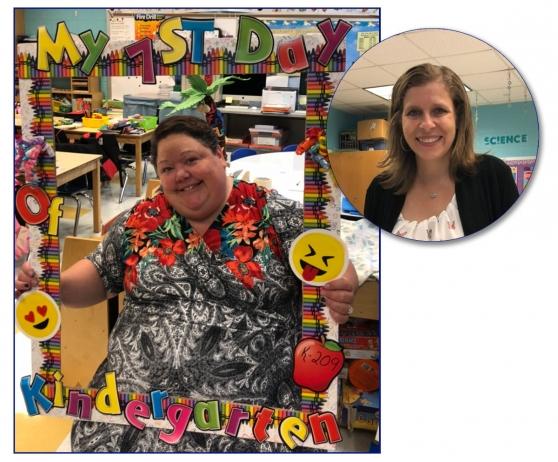
Kelly Aguilar (left) and Lori Brosgole share a kindergarten classroom at PS 212 in Jackson Heights, Queens. Says Brosgole, a special education teacher, "Our regular ed students act as language role models for our students with disabilities."
In Lori Brosgole and Kelly Aguilar’s “colorful, sparkly and fun” kindergarten classroom at PS 212 in Jackson Heights, Queens, a student may start the day in a private conversation with Brosgole, then join Aguilar for a whole-group lesson before returning to Brosgole’s reading group.
“The kids get so much more from having two adults in the room,” says Aguilar of their integrated co-teaching (ICT) classroom, where she and Brosgole have been teaching partners for seven years.
The theory behind integrated co-teaching classrooms, in which one special education teacher and one general education teacher work as partners, is simple: Children with disabilities are supported with specially designed instruction and services that meet their needs in a classroom alongside their typically developing peers.
“We always want to educate children in the least restrictive environment possible,” says Brosgole, a special education teacher. “Our regular ed students act as language role models for our students with disabilities, and the growth we see over the course of the year is phenomenal.”
Pedagogical research into the effectiveness of co-teaching is largely anecdotal. But teachers in successful co-teaching partnerships say the benefits for students are obvious.
“It’s always good to have two teachers in a room, not just in terms of class size, but to get two different perspectives,” says Robert Canzoneri, who has taught English at Richmond Hill HS in Queens alongside special education teacher Peter Colic for nine years. “There are times when we disagree in the classroom about the interpretation of a character we’re teaching, and we’re able to have that discourse in front of the students.”
Canzoneri reached a “turning point” in his approach to co-teaching with a different co-teacher much earlier in his career during a vocabulary lesson on the word “apprentice.”
“A student said, ‘Oh, Ms. Smith is Mr. Canzoneri’s apprentice,’” he recalls. “That’s when I realized, we really need to work more together so that one teacher does not dominate.”
Canzoneri emphasizes the importance of finding time to plan together with a co-teacher, even when prep schedules don’t align. “If you’re going to take on the responsibility of team teaching, you have to go above and beyond to plan together,” he says.
In reading and math, Brosgole and Aguilar tend to group students by ability. In science and social studies, “we try to mix it up so that kids can learn from their peers who are higher functioning,” Brosgole says.
But they agree that flexibility is key.
“We’ve even made adjustments in the middle of a lesson,” says Aguilar. “If what I’m doing right now isn’t working for a student, maybe he goes to sit with Lori for a few minutes.
Researchers Marilyn Friend and Lynne Cook, who are widely considered experts on co-teaching, identified six co-teaching models that most co-teachers use to some extent today in their classrooms.
“Most experienced co-teachers use many approaches, sometimes two or three even within a single lesson,” writes Friend.
Each model has advantages and limitations.
- One teach, one assist: One teacher instructs the whole group while the other teacher assists individual students as needed. Students get one-on-one support as soon as they need it — but they may unintentionally begin to view one teacher as the “leader” in the classroom and the other as merely an assistant.
- One teach, one observe: One teacher instructs the whole group while the other teacher observes the lesson to collect data on students.
- Station teaching: Each teacher instructs a group of students on part of a lesson. Students rotate among “stations” (which may include independent work) in the classroom. Station teaching is great for hands-on work, like science experiments, but teachers have to operate at the same pace to be effective.
- Parallel teaching: Each teacher instructs half the students simultaneously on the same lesson. This approach allows for smaller groups, but it can lead to a scenario in which the special education teacher always works with all the students with disabilities — contrary to the purpose of the ICT model. “We never want to have a group that’s full of only general education kids,” says Aguilar.
- Alternative teaching: One teacher instructs most of the students. The other teacher instructs a small group of students on a different lesson.
- Team teaching: Both teachers share a whole-group lesson. Team teaching is especially satisfying when teachers are comfortable with each other and have similar styles.
These six co-teaching models can provide useful context for teachers as they plan lessons. But what truly drives a successful co-teaching partnership is often intangible.
“It’s very important to like and understand the person you’re working with,” says Brosgole. “We push each other to help better our practice. You learn different styles and different techniques, but you have to be open-minded and flexible.”
ICT classes
The theory behind integrated co-teaching classrooms, in which one special education teacher and one general education teacher work as partners, is simple: Children with disabilities are supported with specially designed instruction and services that meet their needs in a classroom alongside their typically developing peers.
